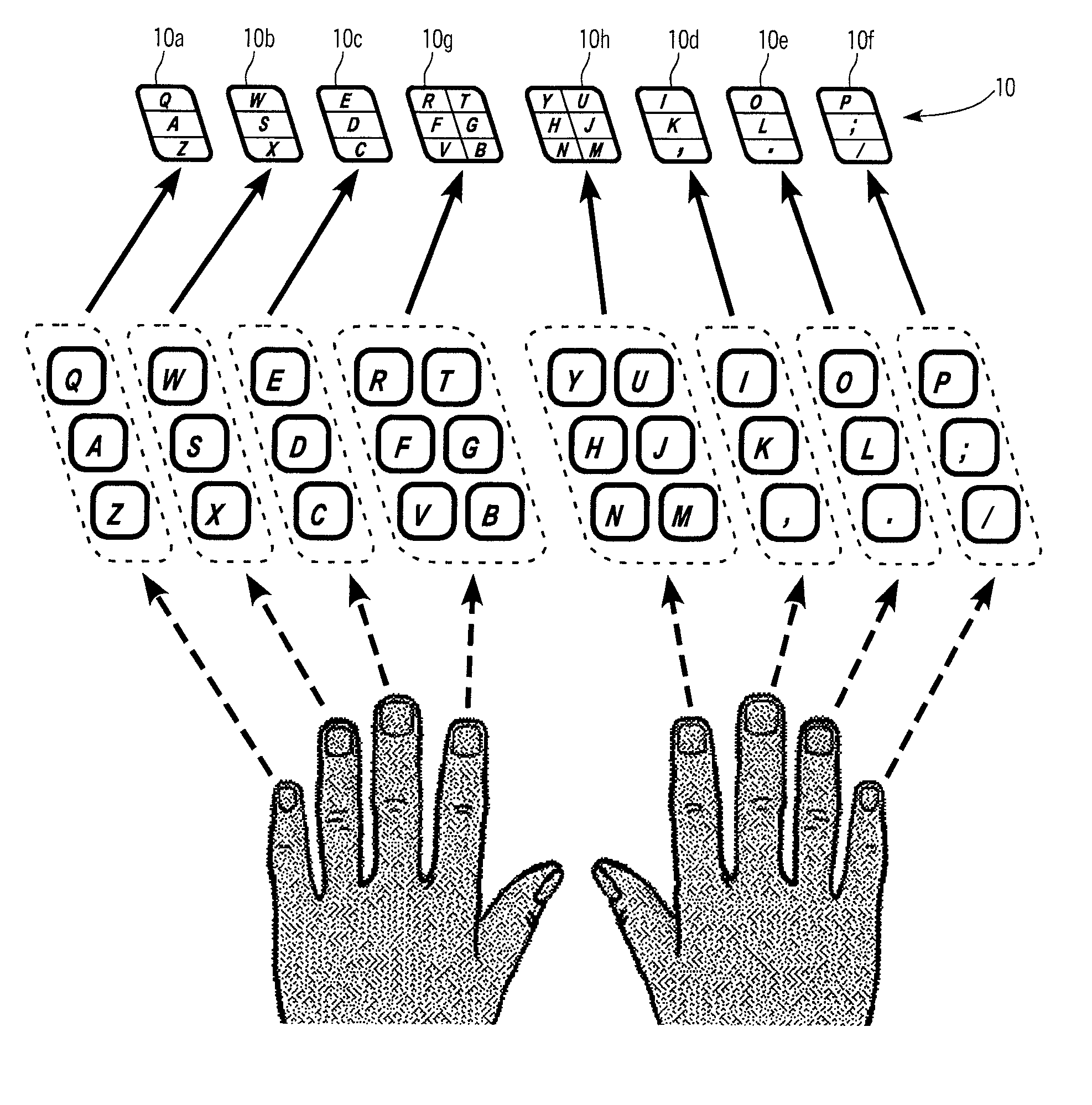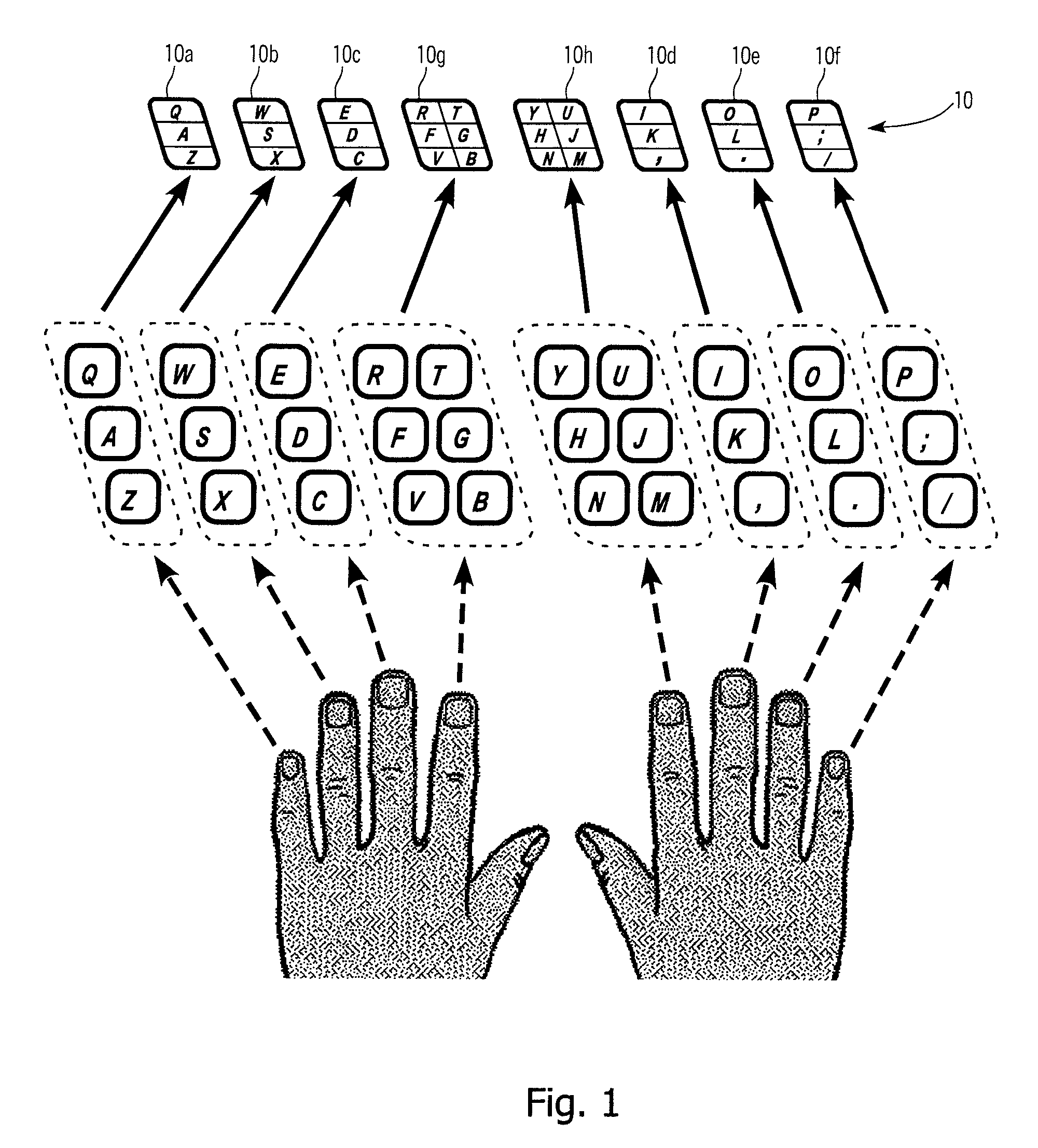Keyboard and Keys
a keyboard and key technology, applied in the field of keys, can solve the problems of not all multi-function key designs provide prevention of sending an incorrect signal, the spacing and overall size of the keyboard is too small to allow touch typing with all eight fingers, and achieve the effect of maintaining the “feel” of the keyboard, avoiding lateral sliding and/or pushing of the keys, and rapid typing speed
- Summary
- Abstract
- Description
- Claims
- Application Information
AI Technical Summary
Benefits of technology
Problems solved by technology
Method used
Image
Examples
embodiment 1
[0120]FIG. 9 shows a three-position key actuated switch of the type generally illustrated in FIG. 1 as keys 10a-10f. The key (90) is a key which may be used for the letters Q, A and Z. The key (90) has two groups of feet. There is a central group of four feet (91) which are all of the same length and which are longer than a second group of feet (92) which are located close to the top and the bottom edges of the key (90). FIG. 9a shows the positions of the feet beneath the key, and a side view when the key is not pressed down. FIG. 9b shows the key when pressed down at position A. In this position, the operative contact feet (91) are shown in black. Three of the four contact feet (91) are required to complete a circuit either by the conductive foot method or by closure of switches by the foot. When three of the four closures that are required for registering of the A keystroke occur, the letter A is signaled. In FIG. 9c there is shown the key when in a position where the letter Q is ...
embodiment 2
[0123]FIG. 11 shows another embodiment of a three-position key actuated switch. In this embodiment, there is a single conductive rubber foot with angled facets located on the underside of the key (111). The foot (112) has pivot edges (113) and (114) which allow the key to tilt or rock back and forth in response to pressure applied at different points. As shown in the side view of FIG. 11a, when no pressure is applied to the key, the key remains above a contact surface (115) located beneath it. On the other hand, when the key is pressed at a point for the letter A, the key moves straight down and closes contacts (116) located directly beneath this center section or facet of the key as illustrated in FIGS. 11d and 11b. When the key is pressed at a top portion, such as for the letter Q, the key will tilt about a pivot axis as shown in FIG. 11c, making contact at contact pair (117) when the upper facet moves downward.
embodiment 3
[0124]FIG. 15 shows another embodiment where a rocking type single foot is used, but the foot is nonconductive. This is shown in FIGS. 15a to 15d. Here the contacts lie beneath the facets of the key (155) and, as shown in FIG. 15b provide for closure at the center contact when the key is pressed straight down at a point for the letter A. This contact is illustrated in FIG. 15b and is identified as reference numeral (158). When the key is pressed at the letter Q the key will tilt about a pivot line (154) allowing closure at a contact (159) which is shown in FIG. 15c.
PUM
 Login to View More
Login to View More Abstract
Description
Claims
Application Information
 Login to View More
Login to View More - R&D
- Intellectual Property
- Life Sciences
- Materials
- Tech Scout
- Unparalleled Data Quality
- Higher Quality Content
- 60% Fewer Hallucinations
Browse by: Latest US Patents, China's latest patents, Technical Efficacy Thesaurus, Application Domain, Technology Topic, Popular Technical Reports.
© 2025 PatSnap. All rights reserved.Legal|Privacy policy|Modern Slavery Act Transparency Statement|Sitemap|About US| Contact US: help@patsnap.com



